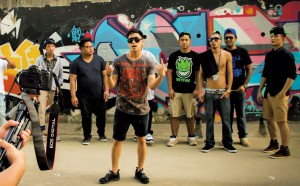Ethnic minority rappers break through cultural boundaries
By Antonia Wong
Inside a dimly-lit room in a youth centre in Aberdeen, an excited crowd of around 20 people stand in front of a small stage, waiting for the next act to appear in a line-up of local indie bands, rappers and beat-box artists. When the DJ starts to spin the decks, and three non-Chinese hip-hop artists take to the stage, the response is at first hushed – as if the audience is not ready to process the English language rhymes. But they soon warm to the trio and groove along to the beats.
The three rappers are members of Dope Boy, an ethnically diverse Hong Kong hip-hop ensemble made up of seven rappers from India, the Philippines, Britain and Brazil. While Cantonese is the dominant language of the underground hip-hop scene in Hong Kong, local audiences can still enjoy and relate to their music.
Dope Boy sees rap as an effective means to express their feelings and connect with the local community. The group’s vision is to merge with the local underground hip-hop scene and create what they believe hip-hop is really about – respect and unity. It is a vision they have embraced since becoming hooked on hip-hop during their secondary school years.
Hector Telmo, also known as SCF-SAiNT, 23, is a Hong Kong born and raised Filipino member of Dope Boy. As his parents are both professional musicians, Telmo has been exposed to different genres of music since he was a child. But he found himself the most drawn to hip-hop, which was wildly popular among the ethnic minority students in Delia Memorial School (Hip Wo) in Kwun Tong, a “designated school” for non-Chinese students.

Telmo recalls that at the school, students would rap and write lyrics in class. He himself started to write his own songs when he was in Form Three. He loved rap because of the strong rhythm, poetic quality and the rhyming syllables, but he was also attracted to it because it was a channel to vent his emotions as he struggled against bullying at school. It was through writing lyrics and performing that he built up a sense of identity. “When you start creating your identity, people see you just like, ‘oh he can do that? That’s so cool’,” Telmo says.
Telmo’s view is shared by his fellow Delia Memorial School alumnus and Dope Boy member, 20-year-old Mohit Kaliandasani. Kaliandasani’s family originally came from India, but like Telmo he was born in Hong Kong. He says his primary school teachers used to dislike him but everything changed for him at secondary school once he started to perform. Rapping earned him respect from schoolmates and teachers. “The passion for music has brought us in front of the crowd and that feeling is very appealing to us,” he says.
But making music is also about expressing emotions and opinions. Kaliandasani and Telmo say they have written about such diverse subjects as breaking up with their girlfriends, the importance of individuality, and about how the world is not such a nice place.
My City, a track written by Dope Boy three years ago tells stories from an ethnic minority perspective, with each member contributing his own fearless verse about what they think of Hong Kong.
The track highlights the importance of diversity and criticises the flaws in Hong Kong’s social system, including how the opinions of ordinary people are not treasured and artists are not given the attention they deserve. Lines include: “Born in an underdog city where the industry is tasteless … Overwork myself each day – CALL IT ENDLESS! Some say MONEY AIN’T EVERYTHING but if you TRYNNA LIVE, IT IS!” and “from the city of lights – Where the officials decide? A lot are underrated – loaded with ego and pride!”
Rap refers to spoken or chanted lyrics and rhymes to music and or just a beat for accompaniment and is a key element of hip-hop music and culture. Hip-hop has its roots in the impoverished black ghettos of the South Bronx of New York City in the 1970s. It evolved as a resistance to mainstream pop culture and as a way for the black youth to respond to oppression and racism.
The original subject matter of early or old-school hip-hop and rap was about partying and having a good time. But from this grew rap as social commentary. Angel Lin Mei-yi, a professor from the Faculty of Education of the University of Hong Kong, has researched local hip-hop culture. She says that in the 1970s and 1980s, before it became the huge commercial industry it is today, hip-hop used to feature rappers who complained about society and the hypocrisy of the adult world.
Lin says ethnic minorities in Hong Kong share a similar lowly, grassroots background to the African Americans in the South Bronx where rap music was born. As they are not given many opportunities to voice their discontent, making and sharing music online has become a way for them to express themselves.
Lin also sees rap as way for the ethnic minorities to break down barriers in their daily lives. “To the young generation, no matter which race you belong to or what language you speak, as long as you like this art form, you are a part of the hip-hop community,” she says.
To Telmo and Kaliandasani, hip-hop unites people regardless of their origin and culture, but it is important to take the first step and be more open-minded in order to mix with and unite people of different ethnic backgrounds.
Back in secondary school, there was a huge gap between the ethnic minority students and the Chinese students at their school because they were put into separate classes. But when their performances won applause from the Chinese students, they discovered that music could transcend ethnicity. That was when the idea of bridging the gap within the local hip-hop community first took root in their hearts and minds.

Telmo says they first had a vision of working with local artists five years ago. Then, in 2012, they decided it was the right time to bring together Hong Kong-based hip-hop artists from all walks of life to produce Hong Kong Underground Cypher 1.0. A cypher is a collaborative track featuring different hip-hop artists who rap freestyle one after the other and try to outwit each other.
But after releasing Cypher 1.0, some people complained, “Why isn’t there a Hong Kong rapper if you call it the Hong Kong Underground Cypher?” Dope Boy remedied the situation for Cypher 2.0 by inviting two local Cantonese rappers to participate.
One of them was Wong Kai-lam, also known as USB. Wong, the 23-year-old local emcee who participated in Cypher 2.0 in October last year, relished his first experience of working with ethnic minority rappers.
Wong mainly raps in Cantonese because rap is about expressing yourself in the language that you feel most comfortable with. Although he may not fully understand Dope Boy’s English lyrics, he says he looks the words up in a dictionary if there is something he does not understand. He respects these ethnic minority rappers who rap in English and in their mother tongues as well.
“We are different in terms of culture even though I still cannot find an example to illustrate this, but I can feel that they are really nice people who are frank and have a genuine heart,” Wong says.

Dope Boy’s Kaliandasani also treasures this subtle bonding with Wong and what hip-hop has brought them. “When we were filming cypher 2.0, it looked like we had known each other forever, but this was the first time we met,” he says.
Hip-hop has taught Kaliandasani not to magnify the differences between people. He does not see language as a barrier that hinders communication between the Chinese and ethnic minorities in Hong Kong. Rather; it is perception that matters.
“I just feel like because there is nothing bringing them together. There’s nothing that links them which is why people have that ego, or they still have the mindset that, they are not like us,” says Kaliandasani. “For us, it is something that brings us together which is hip-hop.”
Dhillon Jeevan Singh, 21, is another ethnic minority rapper who raps mostly in English and sometimes in Punjabi. He participated in Hong Kong Underground Cypher 2.5, and received attention for rapping in Cantonese for the first time.
Singh says he just wanted to show an ethnic Indian could also rap in Chinese. He says he usually feels more comfortable speaking to others in his own community, but rap allows him to put aside his ethnicity. “When it comes to music it doesn’t matter where you are from, it just connect, that’s the most amazing thing,” he says.
Although rap builds a bridge between the Chinese and the ethnic minorities, Singh suggests that local Cantonese rappers rarely step out of the box because the Chinese community is still quite reserved.
But Singh still believes that being an ethnic minority opens more doors for him than it closes. “If you can speak Chinese, as an ethnic minority, and you also make music, they understand your music. They start to break their stereotype,” he says.
Edited by Katrina Lee











































